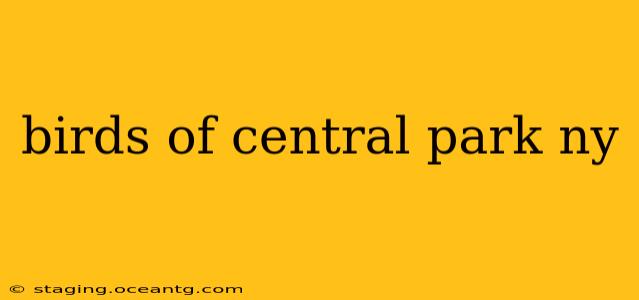Central Park, a vibrant green heart in the concrete jungle of New York City, is surprisingly teeming with avian life. From the common pigeon to the elusive peregrine falcon, a diverse array of bird species call this urban oasis home, or at least make it a frequent stopover on their migratory routes. This guide will explore the rich biodiversity of Central Park's birds, helping you identify some of its feathered residents and understand what makes this park such a haven for birdwatching.
What birds can you see in Central Park?
Central Park boasts an impressive list of bird species, varying by season. Common year-round residents include the ubiquitous American Robin, the chattering House Sparrow, and the ever-present Rock Pigeon. During the spring and summer months, migratory birds swell the ranks, adding species like the elegant Northern Cardinal, the bright yellow American Goldfinch, and the graceful Mourning Dove. Winter brings its own set of visitors, such as the hardy Northern Flicker and the striking Downy Woodpecker. The park's varied habitats—from the Ramble's dense woodlands to the North Woods' more open spaces and the still waters of the lake—cater to a wide range of avian preferences. Dedicated birdwatchers can even spot rarer species, highlighting the unexpected richness of urban biodiversity.
What is the best time of year to birdwatch in Central Park?
The best time for birdwatching in Central Park depends on your target species. Spring and fall migrations bring the highest diversity, with a flurry of activity as birds pass through on their journeys. Spring, in particular, offers the spectacle of breeding plumage and the energetic calls of nesting birds. Summer provides opportunities to see nesting birds and their young, while winter offers the chance to observe hardier species that brave the cold. Each season provides a unique and rewarding birdwatching experience. Early mornings are generally considered the best time of day for birdwatching, as birds are most active then.
What are the best places to birdwatch in Central Park?
Several locations within Central Park are particularly good for birdwatching. The Ramble, with its dense woods and varied vegetation, is a prime spot for observing woodland birds. The North Woods offers more open habitats, attracting different species. The lake and its surrounding areas attract waterfowl and other water-loving birds. The Conservatory Garden and other areas with flowering plants attract nectar-feeding birds. Finally, the Great Lawn provides a vast open space where birds can be spotted from afar. Exploring different areas of the park increases your chances of encountering a wider variety of birds.
What kind of birds live in Central Park year round?
Several bird species reside in Central Park year-round, adapting to the urban environment. These include the American Robin, House Sparrow, Rock Pigeon, Mourning Dove, and Northern Cardinal. These birds have successfully adapted to human presence and find sufficient food and shelter within the park's boundaries. Their resilience demonstrates the ability of certain species to thrive even in heavily urbanized settings.
Are there any rare birds in Central Park?
While the majority of birds in Central Park are common species, the park occasionally attracts rare visitors. These can include vagrant birds from further afield, blown off course during migration. Birdwatchers regularly report unexpected sightings, adding to the excitement and unpredictability of Central Park birding. Consulting local birding groups and online resources can provide updates on recent rare bird sightings.
Conclusion
Central Park's diverse avian population is a testament to the surprising resilience of nature in urban settings. Whether you're a seasoned birdwatcher or a curious newcomer, exploring the park's feathered inhabitants offers a rewarding and enriching experience. So grab your binoculars, take a walk, and discover the hidden avian wonders of this iconic New York City landmark. Remember to respect the birds and their habitat while enjoying the beauty of Central Park's avian biodiversity.
